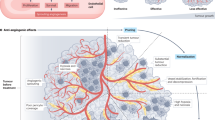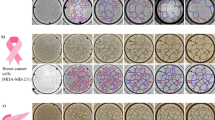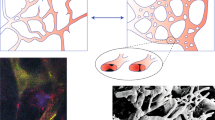Summary
The vascular architecture of four different tumour cell lines (CaX, CaNT, SaS, HEC-1B) transplanted subcutaneously in mice was examined by means of microvascular corrosion casting in order to determine whether there is a characteristic vascular pattern for different tumour types and whether it differs significantly from two normal tissues, muscle and gut. Three-dimensional reconstructed scanning electron microscope images were used for quantitative measurements. Vessel diameters, intervessel and interbranch distances showed large differences between tumour types, whereas the branching angles were similar. In all tumours, the variability of the vessel diameters was significantly higher than in normal tissue. The quantitative data provide strong evidence for a characteristic vascular network determined by the tumour cells themselves.
Similar content being viewed by others
Article PDF
Change history
16 November 2011
This paper was modified 12 months after initial publication to switch to Creative Commons licence terms, as noted at publication
References
Algire, G. H. (1943). Microscopic studies of the early growth of a transplantable melanoma of the mouse using the transparent chamber technique. J Natl Cancer Inst 4: 13–22.
Bicknell, R. (1994). Vascular targeting and the inhibition of angiogenesis. Ann Oncol 5: 45–50.
Davidson, S. E., Ngan, R., Wilks, D. P., Moore, J. V. & West, C. M. (1994). A comparison of four methods for assessing tumor vascularity in carcinoma of the cervix. Int J Oncol 5: 639–645.
Denekamp, J. (1984). Vascular endothelium as the vulnerable element in tumours. Acta Radiol Oncol 23: 217–225.
Endrich, B. & Vaupel, P. (1998). The role of the microcirculation in the treatment of malignant tumors: facts and fiction. Morphological aspects of tumor angiogenesis and microcirculation. In Blood Perfusion and Microenvironment of Human Tumors, Implications for Clinical Radiooncology Molls M and Vaupel P, (eds), pp. 19–40. Springer: Berlin
Falk, P. (1982). Differences in vascular pattern between the spontaneous and the transplanted C3H mouse mammary carcinoma. Eur J Cancer Clin Oncol 18: 155–165.
Folkman, J. (1976). The vascularization of tumors. Sci Am 234: 58–64, 70–73.
Folkman, J. & D’Amore, P. A. (1996). Blood vessel formation: what is its molecular basis? Cell 87: 1153–1155.
Gerlowski, L. E. & Jain, R. K. (1986). Microvascular permeability of normal and neoplastic tissues. Microvasc Res 31: 288–305.
Goodall, C. M., Sanders, A. G. & Shubik, P. (1965). Studies of vascular patterns in living tumors with a transparent chamber inserted in the hamster cheek pouch. J Natl Cancer Inst 35: 497–521.
Grunt, T. W., Lametschwandtner, A., Karrer, K. & Staindl, O. (1986). The angioarchitecture of the Lewis lung carcinoma in laboratory mice. A light microscopic and scanning electron microscopic study. Scan Electron Microsc 557–573
Jain, R. K. (1988). Determinants of tumor blood flow: a review. Cancer Res 48: 2641–2658.
Konerding, M. A., Fait, E., Dimitropoulou, C., Malkusch, W., Ferri, C., Giavazzi, R., Coltrini, D. & Presta, M. (1998). Impact of Fibroblast Growth Factor-2 on tumor microvascular architecture: a tridimensional morphometric study. Am J Pathol 152: 1607–1616.
Konerding, M. A., Steinberg, F. & Budach, V. (1989). The vascular system of xenotransplanted tumors: scanning electron and light microscopic studies. Scanning Microsc 3: 327–336.
Konerding, M. A., Steinberg, F., van Ackern, C., Budach, V. & Streffer, C. (1992). Comparative ultratructural studies of the vascularity in different human xenografted tumours. In Immunodeficient Mice in Oncology. Contributions to Oncology Fiebig HH and Berger DP (eds), pp. 169–179. Karger: Basel
Less, J. R., Skalak, T. C., Sevick, E. M. & Jain, R. K. (1991). Microvascular architecture in a mammary carcinoma: branching patterns and vessel dimensions. Cancer Res 51: 265–273.
Lewis, W. H. (1927). The vascular patterns of tumors. Johns Hopkins Hosp Bull 41: 156–175.
Malkusch, W., Konerding, M. A., Klapthor, B. & Bruch, J. (1995). A simple and accurate method for 3-D measurements in microcorrosion casts illustrated with tumour vascularization. Anal Cell Pathol 9: 69–81.
Margulis, A. R., Carlsson, E. & McAllister, W. H. (1961). Angiography of malignant tumors in mice. Acta Radiol 56: 179–192.
Milne, E. N., Margulis, A. R., Noonan, C. D. & Stoughton, J. T. (1967). Histologic type-specific vascular patterns in rat tumors. Cancer 20: 1635–1646.
Solesvik, O. V., Rofstad, E. K. & Brustad, T. (1982). Vascular structure of five human malignant melanomas grown in athymic nude mice. Br J Cancer 46: 557–567.
Thiersch, C. (1865). Der Epithelialkrebs namentlich der Haut. Engelmann: Leipzig
Thomlinson, R. H. & Gray, L. H. (1955). The histological structure of some human lung cancers and the possible implications for radiotherapy. Br J Cancer 9: 539
Vaupel, P. & Gabbert, H. (1986). Evidence for and against a tumor type-specific vascularity. Strahlenther Onkol 162: 633–638.
Virchow, R. (1863). Die krankhaften Geschwülste. Berlin: Hirschwald
Warren, B. A. (1979). Tumor angiogenesis. In Tumor Blood Circulation. Angiogenesis, Vascular Morphology and Blood Flow of Experimental and Human Tumors Peterson HI (ed), pp. 47–75. CRC Press: Boca Raton
Author information
Authors and Affiliations
Rights and permissions
From twelve months after its original publication, this work is licensed under the Creative Commons Attribution-NonCommercial-Share Alike 3.0 Unported License. To view a copy of this license, visit http://creativecommons.org/licenses/by-nc-sa/3.0/
About this article
Cite this article
Konerding, M., Malkusch, W., Klapthor, B. et al. Evidence for characteristic vascular patterns in solid tumours: quantitative studies using corrosion casts. Br J Cancer 80, 724–732 (1999). https://doi.org/10.1038/sj.bjc.6690416
Received:
Revised:
Accepted:
Published:
Issue date:
DOI: https://doi.org/10.1038/sj.bjc.6690416
Keywords
This article is cited by
-
Therapy-induced modulation of tumor vasculature and oxygenation in a murine glioblastoma model quantified by deep learning-based feature extraction
Scientific Reports (2024)
-
Vessel size as a marker of survival in estrogen receptor positive breast cancer
Breast Cancer Research and Treatment (2023)
-
Study of the calculation of the oxygen enhancement ratio for a carbon ion beam with fraction and linear energy transfer using various survival models
Journal of the Korean Physical Society (2022)
-
A comparative analysis of cell surface targeting aptamers
Nature Communications (2021)
-
Tumor Ensemble-Based Modeling and Visualization of Emergent Angiogenic Heterogeneity in Breast Cancer
Scientific Reports (2019)



